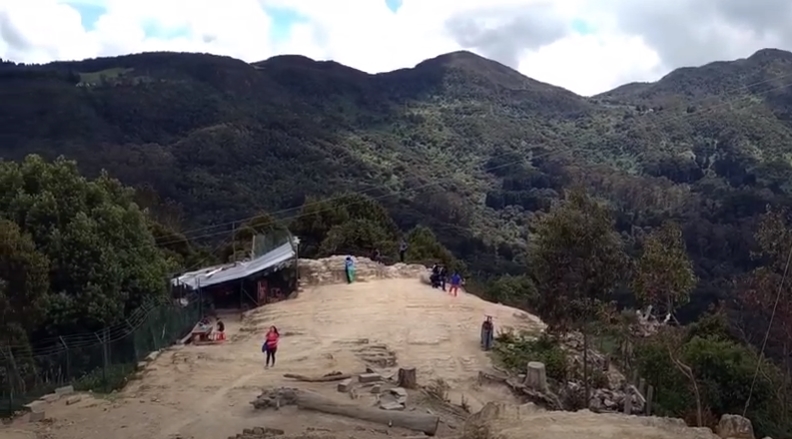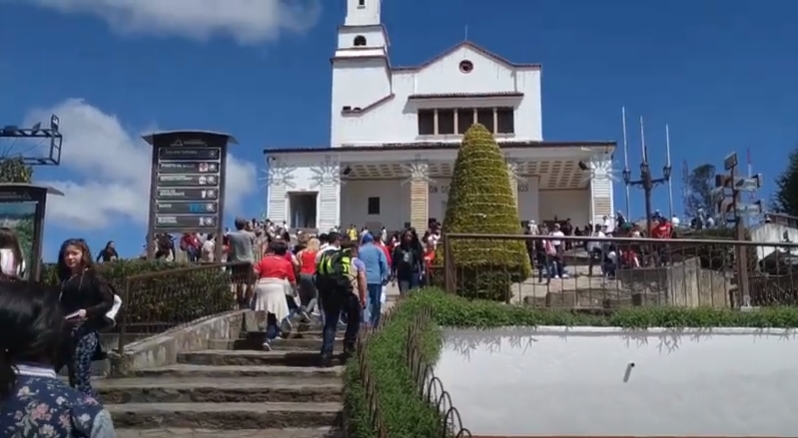The Jet of Quevedo
History says that Chorro de Quevedo was the place where the Zipa observed the Bogotá savanna. In the year 1832, Father Agustino Quevedo installed a public water source, water that was maintained until 1986.

Based on models and old images in 1969, the square was rebuilt. At which time the place began to be given relevance, the old fountain and the chapel of San Miguel del Príncipe were recreated.
Apparently inspired by the Humilladero, which was a humble hermitage installed by the conquistadors in what is now the Park Santander.
A historical place called El Chorro de Quevedo
La Plazoleta del Chorro que Quevedo is one of the main historical and cultural attractions of Bogotá; visiting it is transporting yourself to another era, surrounded by colonial buildings, built on cobblestone streets.
In the surroundings of Chorro de Quevedo we find the most important universities in the capital and in all of Colombia.
The Calarca theater, the Free Theater, the La Candelaria foundation, the University the Externado, among other places, are part of the surroundings of the jet of Quevedo.
It is and has been an epicenter of socio-cultural encounters, a source of work and a point of reference in La Candelaria and the Historic Center of Bogotá.
Millions of men and women from all over the world have walked its cobbled streets. The inhabitants of the sector in colonial times resorted there to extract water, for domestic tasks.
El chorro de Quevedo is a place to meet and interact cultural ideas in an atmosphere of laughter and hundreds of activities that allow us to have a more direct contact with the culture of Bogotá.
Currently the plaza is visited daily by tourists, students, intellectuals of the city, among many others and is surrounded by many shops such as restaurants, cafes and craft shops.

What do I find in Chorro de Quevedo?
In Chorro de Quevedo you can meet new friends, take a walk, enjoy the fountain, learn about the place and its foundation, know the chapel, take a picture with the graffiti on the walls, the food is exquisite, we can drink good chicha or a delicious beer.
The streets are narrow and have very particular names, in general it is a pleasure that you should not miss from Bogotá both as a tourist or as a citizen.
Bogotá is the capital of Colombia, the attractions and tourist places in Bogotá are innumerable, in this great city we find all kinds of alternatives for tourism, fun and shopping.
I invite you to know and visit some of the most representative of the town of Santa Fe….
MONSERRATE AND THE PLAZA DE BOLÍVAR
MONSERRATE HILL:
- It is one of the most representative places in Bogotá, nationally and internationally.
Located at 3152 meters high above sea level, it houses on its top the sanctuary of the fallen Lord of Monserrate, a place of pilgrimage for nationals and foreigners, surrounded by lush vegetation and from where you can appreciate the best landscape of the Bogota savanna.
HISTORY
When Gonzalo Jiménez de Quesada chose the site to found Santa Fe, he was struck by the two enormous hills that watch over the city, and on its top he placed two large crosses, a century later don Juan de Borja.
President of the New Kingdom Granada, authorized Don Pedro Solís de Valenzuela in 1640 the construction of a chapel dedicated to the Morena Virgin of Montserrat, whose sanctuary is located in the province of Barcelona, in Spain.
- Don Pedro Solís, Who achieved not only a beautiful image of impressive artistic value, but also managed to gather the religious faith of the city.
Since that time, every day, thousands of believers devoutly climb the steps that lead to the sanctuary at the top as a penitential act. While thousands of other tourists, athletes or curious people arrive on foot, by cable car or cable car
MYTHS
There are people who say that the sculpture of the fallen lord grows hair, other people say that when he does not want to go down from the hill it becomes so heavy that they cannot move it, and other people say that the fallen lord of Monserrate separates the couples who do not agree, otherwise unites them forever.

RESTAURANTS
In the San Isidro house there is a wide variety of foods, and there are dates where special dishes are served:
In Lent: Fish
May and June: French menu
September: Lobster
December: Wine and champagne
The Santa Clara house was originally built in Usaquen and was moved to Monserrate, where typical Colombian dishes are served and you can enjoy the «onces santafereñas»
BELIEFS
The fallen lord of Monserrate and his location hide many mysteries, which focus on the rites and miracles that people follow. The fallen lord of Monserrate has become the patron saint of Bogotanos, who go up to pray day by day.
TRADITIONS
The pilgrimages to the hill have become massive, and there are still people climbing first thing on Sundays on their knees or blindfolded, as a sacrifice in exchange for some favor
THE CROSS
It was built as a symbol of the descents of the fallen lord of Monserrate, which are the following:
1916: It is said that it was to stop a severe drought
1952: It was in order to ask for peace, since the country was going through a difficult situation of violence
1998: It was for the day of prayer «Bogotá prays for the peace of Colombia»
(On these dates the cross was built)
2009: It was due to the closure of the pedestrian path by fixes
2014: For the celebration of the jubilee of the 450 years of the Archdiocese of Bogotá
BOLIVAR PLAZA
Formerly known as the Plaza Mayor, it is one of the most important places in the city and in the country as it is an important social, cultural, and political setting.
Around which the most important decisions are made for Colombians and for the history of Colombia.
And it also houses some of the most representative and important buildings in the country. Then we will take a short tour of the most representative buildings in the Plaza de Bolivar.
THE PRIMED CATHEDRAL OF COLOMBIA
Despite earthquakes and architectural errors, which have caused it to be rebuilt several times between 1538 and 1823, it has remained imposing on the eastern side of Plaza de Bolívar for several centuries.
- The Capuchin architect cleric Fray Domingo de Petrés, was responsible for its latest renovation. Its walls house the remains of national heroes and figures, among which stand out: Gonzalo Jiménez de Quesada, Antonio Nariño.
The painter from the neighborhood Gregorio Vásquez de Arce y Ceballos. Additionally, a large collection of books dating from 1612 is under its Processional Custody.
This interests you:
http://lomasdelared.com/barrio-la-candelaria-colombia/
NATIONAL CAPITOL
It is an architectural work worthy of being admired by all its visitors and passers-by. With its neo-classical and Renaissance style it is a reflection of the political transformation in
THE LIÉVANO PALACE
The entire western part of the Plaza de Bolívar is made up of the Mayor’s Office of Bogotá.
This three-storey rectangular building, in the same neoclassical style as the other buildings, began to be erected in 1902.
Its style is mainly characterized by the treatment of the central courtyard and the stonework.
The first time that a left-wing mayor walked the corridors of the Mayor’s Office was on January 1, 2004, when Luis Eduardo Garzón took office to direct the policies of the capital.

VASE HOUSE OR MUSEUM OF JULY 20, 1810
In 1810, various establishments operated inside it, the most important evidently being that of the Spanish José González Llorente, the events that gave Colombia and its population independence were triggered.
Visitors can currently appreciate the exhibition of the museum, which is distributed in nine rooms:
the Vase Room, the Minutes Room, the Hall of the heroes, the Supreme Board Room, the Bogota Room, the Antonio Nariño Room, the Heroines Room, the Bolívar and Santander Hall and Oratory.
COURTHOUSE:
A steeped in History, perhaps the most energetically remembered in the country.
The first Court building was built on 11th Street in 1921 and was destroyed due to a fire during the so-called Bogotazo in April 1948 after the murder of Jorge Eliecer Gaitan.
Later, a new building was erected in the Plaza de Bolivar that was also destroyed during the well-known Taking of the Palace of Justice by the M-19.
Perpetrated on November 6, 1985, after the taking that left an undetermined number of deaths and disappeared the ruins remained intact for 4 years until it was completely demolished to build the current building
